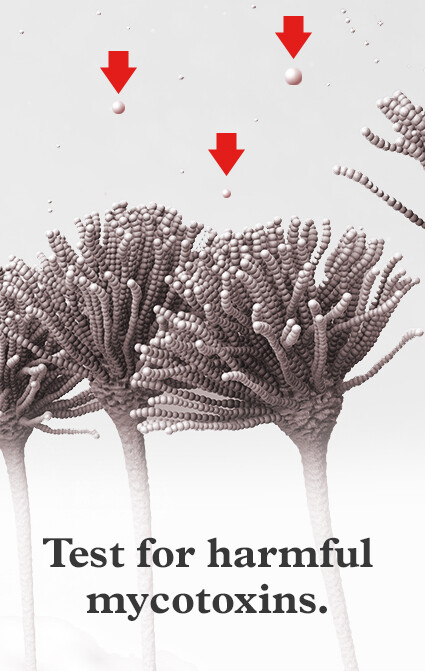Exactly How Mycotoxin Testing Aids Stop Contamination and Secure Food Supplies

Mycotoxin testing is a vital practice in the food market, serving as a frontline defense against contamination by unsafe contaminants created by molds. With the application of advanced methods like High-Performance Fluid Chromatography (HPLC) and Fluid Chromatography-Mass Spectrometry (LC-MS), food manufacturers can precisely evaluate and find mycotoxin levels in farming products.
Understanding Mycotoxins
Comprehending mycotoxins starts with recognizing that they are harmful second metabolites generated by particular molds, which can pollute agricultural products. These metabolites are not important for the growth or recreation of the fungi however can have serious effects for human and animal health. Mycotoxins are generally found in staple crops such as corn, wheat, barley, and nuts, where they can multiply under certain conditions of moisture and temperature level.
There are numerous types of mycotoxins, each created by different fungal varieties. Fusarium types create trichothecenes and fumonisins, both of which are associated with various acute and chronic wellness concerns.

Dangers of Mycotoxin Contamination
The threats of mycotoxin contamination are diverse, posing substantial dangers to both food safety and public health. Mycotoxins, harmful substances generated by particular types of fungi, can pollute a large variety of agricultural items including cereals, nuts, spices, dried out fruits, and coffee.
Financial effects are another significant problem. Infected crops can cause considerable monetary losses for farmers and food manufacturers as a result of reduced yields and the demand for expensive decontamination actions. Additionally, worldwide profession can be dramatically impeded as nations implement rigorous mycotoxin laws to protect their populations, leading to declined deliveries and strained profession relationships.
Ecological variables such as climate change exacerbate the danger of mycotoxin contamination. Variations in temperature and humidity can develop beneficial conditions for fungal growth, boosting the possibility of contamination occasions. Thus, understanding and reducing these threats are vital for guaranteeing the safety and security and honesty of international food materials.
Methods of Mycotoxin Testing
Properly identifying mycotoxin contamination in agricultural products is important for guarding public health and wellness and preserving food safety requirements. Various techniques are employed to spot and quantify mycotoxins, each offering particular benefits and limitations.
High-Performance Liquid Chromatography (HPLC) is a widely used method as a result of its high sensitivity and accuracy. It involves separating mycotoxins from various other substances in a sample, allowing exact quantification. Liquid Chromatography-Mass Spectrometry (LC-MS) integrates fluid chromatography with mass spectrometry to offer detailed molecular details, making it specifically useful for determining numerous mycotoxins simultaneously.

Gas Chromatography-Mass Spectrometry (GC-MS) and Thin-Layer Chromatography (TENDER LOVING CARE) are likewise used, each with distinct applications. GC-MS works for volatile mycotoxins, while TLC uses a simpler, economical alternative for preliminary screening.
Advantages of Regular Testing
Routine screening for mycotoxins in agricultural products offers many benefits, considerably adding to public wellness and food safety. By determining contamination early, routine testing helps stop the circulation of harmful foods, thereby reducing the threat of mycotoxin-related illnesses among consumers. This aggressive approach not only safeguards human health but also enhances the overall quality of food products.
Various nations and regions have developed stringent limits for mycotoxin degrees in food and feed. Sticking to these limits with right here regular screening ensures that providers and manufacturers satisfy lawful standards, consequently preventing charges and profession obstacles.
In addition, normal mycotoxin screening can bring about significant financial benefits. Early discovery of contamination enables prompt intervention, reducing potential losses from widespread contamination. Implementing normal screening methods can also decrease recall costs and associated liabilities, which can be economically ruining.
Furthermore, normal testing provides valuable data that can educate far better farming methods and storage space conditions. By understanding patterns see this page of contamination, producers can take on precautionary measures, thus contributing and reducing future risks to the sustainability of the food supply chain.
Applying Examining Procedures
Implementing reliable mycotoxin testing protocols is crucial for guaranteeing the safety and quality of farming products. Establishing a durable screening structure involves numerous crucial steps, starting with the identification of possible contamination points within the production and supply chain. This consists of pre-harvest, post-harvest, storage, and distribution phases. Each stage has to be scrutinized to identify where mycotoxin contamination is probably to take place.
Once important control factors are determined, selecting suitable screening techniques is essential. Common techniques include enzyme-linked immunosorbent assay (ELISA), high-performance liquid chromatography (HPLC), and mass spectrometry (MS) Each technique has its weak points and toughness; hence, choosing the correct one depends upon the certain mycotoxin being evaluated, the called for level of sensitivity, and offered sources.

Finally, incorporating the testing procedures right into an extensive food safety monitoring system is advisable. This improves traceability and makes it possible for quick corrective activities when contamination is found, thereby guarding the honesty of the food supply chain.
Conclusion
Mycotoxin screening is crucial in preventing contamination and securing food supplies by enabling very early detection of damaging contaminants generated by mold and mildews in agricultural products. Normal screening enhances brand online reputation, economic security, and trust fund in food security by minimizing contamination-related losses and maintaining high criteria in food production.
Mycotoxin screening is an indispensable technique in the food market, offering as a frontline protection versus contamination by damaging toxic substances produced by mold and mildews. An incorporated approach including agricultural practices, storage management, and regular screening can news reduce the threats associated with mycotoxin contamination, guaranteeing food safety and public wellness.
The threats of mycotoxin contamination are multifaceted, posing considerable dangers to both food security and public health.Routine testing for mycotoxins in farming items offers various advantages, considerably adding to public wellness and food safety.Mycotoxin screening is essential in protecting against contamination and guarding food supplies by enabling very early discovery of hazardous toxins created by mold and mildews in farming items.